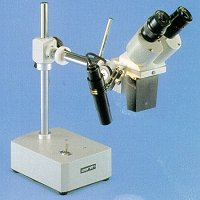|
| |
STL-80
 Zenith
Microscopes
Zenith
Microscopes
Stereoscopic Microscopes
STL-80
Zenith STL-80 x10/x20 Long Arm Stereoscopic Microscope
A very useful and versatile instrument for use throughout education and
industry. Features 12v 10w halogen illumination and two magnifications
of x10 and x20 as standard. The long boom arm is adjustable to vary the
viewing angle of the stereoscopic head. The heavy microscope base
ensures stability. The long working distance of 231mm and a field of
view of 20mm make it ideal for operations such as dissection and fine
assembly work.
Standard Specification:
- Magnification x10, x20
- Paired x10 & x20 widefield eyepieces
- Achromatic Objective Pair x1
- Working distance 231mm
- Field of view 20mm
- 230v/12v 10w halogen illumination
- Binocular head inclined 45 degrees for comfortable viewing
- Full interpupillary and dioptric adjustment provided
- Boom arm can be raised on its pillar to accommodate specimens of
varying sizes
- Rack and Pinion focussing
- Supplied in polystyrene pack
- Dimensions 390x130x390mm
- Weight Approx 6kg
The first useful microscope was developed in the Netherlands in the early 1600s.[1] Three different eyeglass makers have been given credit for the invention: Hans Lippershey (who also developed the first real telescope); Hans Janssen; and his son, Zacharias. The coining of the name "microscope" has been credited to Giovanni Faber, who gave that name to Galileo Galilei's compound microscope in 1625. (Galileo had called it the "occhiolino" or "little eye".)
The most common type of microscope—and the first to be invented—is the optical microscope. This is an optical instrument containing one or more lenses that produce an enlarged image of an object placed in the focal plane of the lens(es). There are, however, many other microscope designs.
| Accessories |
| SB-12 |
Replacement
12v 10w bulb |
| EP-15 |
x15
widefield eyepiece (2 req'd) |
| OG-1 |
x0.5
objective pair |
|
Product Code: STL-80
build_table('etistore',array('hestl80')); ?>
|
| |
|

